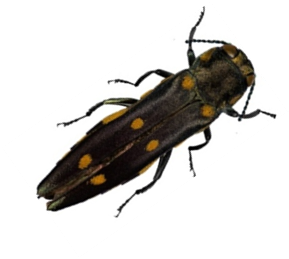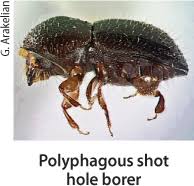The native hardwood trees of southern California are under threat from several non-native insects and insect/pathogen complexes. I provided some recent information on one of these, the Kuroshio shot hole borer, in April; and a description of Californians’ efforts to counter the threat in August of last year. I think it is time to provide a more comprehensive update on the species.
Invasive Shot Hole Borers
I have blogged several times about the damage being caused to riparian trees in southern California by the polyphagous and Kuroshio shot hole borers – collectively referred to as the “invasive shot hole borers” or ISHB.
One of the most interesting sources of information about the shot hole borers are the series of visual surveys carried out by Orange County Parks under the leadership of Cathy Nowak (who has now retired). The most recent surveys were conducted in spring 2018 while deciduous trees were still dormant, so those estimates are based on the number of beetle gallery holes detected. An estimated 52,000 trees in the County’s parks are infested by either PSHB or KSHB. Eight regional parks and one historic house were surveyed. Only one large park remains uninfested. Comparing the results in 2018 to those of earlier surveys showed that percentages of host trees (in which the beetle can reproduce) that are infested rose over 2 years or less in seven of the parks – from a 9% increase in one park to a five-fold increase at another park with very low numbers of trees and low overall infestation rate earlier. The second highest increase is 89%.
The most heavily hit hosts are species long recognized as hosts See writeup on the borers here. Those with infestation rates exceeding 70% in one or more parks were
Acacia sp
Alnus rhobifolia (white alder)
Baccharis salicifolia (mule fat)
Erythrina caffra (coral tree)
Koelreuteria bipinnata (Chinese Flame tree*)
Koelreuteria paniculata (golden raintree)
Liquidambar styrachiflua (sweetgum)
Parkinsonia aculeate (palo verde)
Platanus occidentalis (American Sycamore)
Platanus racemose (California sycamore)
Platanus x hispanica (London plane)
Populus fremontii (Fremont cottonwood)
Populus trichocarpa (black cottonwood)
Quercus robur (English oak)
Salix spp. (willow)
* Chinese flame trees support ISHB only within cankered wood – other parts of the tree excrete thick gumming sap that protects.
Current information supports the vulnerability of California sycamore, and guidance that those seeking to learn whether the beetles have established should focus their surveys on sycamores.
As I have noted numerous times, several reproductive hosts are widespread in other parts of the country and could presumably support infestations there. These include box elder (not included in the Orange County surveys), sweetgum, and two magnolias – southern magnolia (M. grandiflora) and sweet bay (M. virginiana). Thirty-eight percent of the Magnolia grandiflora in one park were infested, although none was in three other parks. Koelreuteria spp. are a widely planted exotic across the country – although their role in spreading the disease appears to be limited by fact that they support ISHB development only in cankered wood. Birches have not been determined to be reproductive hosts, although one birch tree in one park had insect exit holes. Casuarina cunnninghamiana is also not known to be a reproductive host; trees in this genus are widespread invaders in Florida.
The good news is that none of a total of 12 southern live oaks (Quercus virginiana) growing in three parks had been attacked.

Goldspotted oak borer
The goldspotted oak borer attacks California black oak, coast live oak, and canyon live oak. It is now widespread and continuing to spread in San Diego County. Officials report that is now established in more than 10 parks in the County.
There is a heavy GSOB infestation in Idyllwild, on the eastern edge of Riverside County. This outbreak is clearly linked to importation of infested firewood. Due to the heavy 2017 fire season, planned removal of “amplifying” trees (heavily infested trees that support large numbers of reproducing beetles) did not occur – and the outbreak is growing. Trees in the San Bernardino National Forest are at risk; 13 were removed in 2017.
In Los Angeles County, so far only one site has been infested – Green Valley (which includes both private land and nearby portions of the Angeles National Forest). An estimated 50,000 oaks are in the area. Officials are removing the “amplifier” trees; they expect they might have to remove close to 3,000 trees at a cost of $6 million. Officials are also treating some trees.
A newly detected heavy infestation has been detected at campgrounds in the Trabuco Ranger District in the Cleveland National Forest. Forest Service officials are debating management options, with an eye to protecting as many coast live oaks as possible. They have had success in the past by treating some trees with chemicals.
Meanwhile, scientists will be trying to evaluate the effect of fire since the 2017 fires burned several infested areas, e.g., Weir Canyon in Orange County.
The principal management strategy is to identify and remove heavily infested “amplifier” trees. The wood and bark must be disposed of properly and quickly – if the wood is left on the ground over night, people take it – thereby spreading the insects. High-value trees that are not heavily infested can be protected by application of the topical contact insecticide Carbaryl on the lower trunk. Officials are also experimenting with oak restoration using either planting of acorns or promoting root sprouting of trees that have had to be cut down.
Thousand Cankers Disease
Thousand cankers disease of walnuts is very widespread throughout California, but it is not causing widespread rapid tree deaths. Juglans californica has multiple stems. If one is killed, the others usually survive. The impact on J. hindsii is greater because it has a single stem and is grown as a street tree. California officials last conducted a survey of walnuts in the state in 2015, at the height of the drought. They appear to be confident that the age of this survey has not affected their assessment of the risk.
Posted by Faith Campbell
We welcome comments that supplement or correct factual information, suggest new approaches, or promote thoughtful consideration. We post comments that disagree with us — but not those we judge to be not civil or inflammatory.
